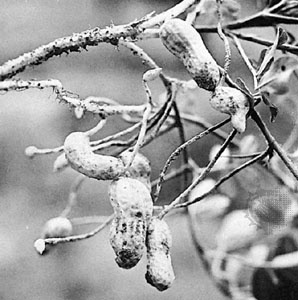peanut
plant
also called Groundnut, Earthnut, or Goober,
 the pod, or legume, of Arachis hypogaea (family Fabaceae), which has the peculiar habit of ripening underground. (Despite its several common names, it is not a true nut.) It is a concentrated food; pound for pound, peanuts have more protein, minerals, and vitamins than beef liver; more fat than heavy cream; and more food energy (calories) than sugar. The plant is an annual, ranging from an erect or bunch form 450–600 millimetres (18–24 inches) high, with short branches, to a spreading, or runner, form 300–450 mm high with branches up to 600 mm long that lie close to the soil. The stems and branches are sturdy and hairy; leaves are pinnately compound with two pairs of leaflets. The flowers are borne in the axils of the leaves; what appears to be a flower stalk is a slender calyx up to 40 mm long; the golden-yellow petals are about 10 mm across. The pods are most commonly 25–50 mm long, with two or three seeds, oblong, roughly cylindrical with rounded ends, contracted between the seeds, and have a thin, netted, spongy shell. The seeds vary from oblong to nearly round; seed coat colours range from whitish to dark purple, but mahogany red, rose, and salmon predominate.
the pod, or legume, of Arachis hypogaea (family Fabaceae), which has the peculiar habit of ripening underground. (Despite its several common names, it is not a true nut.) It is a concentrated food; pound for pound, peanuts have more protein, minerals, and vitamins than beef liver; more fat than heavy cream; and more food energy (calories) than sugar. The plant is an annual, ranging from an erect or bunch form 450–600 millimetres (18–24 inches) high, with short branches, to a spreading, or runner, form 300–450 mm high with branches up to 600 mm long that lie close to the soil. The stems and branches are sturdy and hairy; leaves are pinnately compound with two pairs of leaflets. The flowers are borne in the axils of the leaves; what appears to be a flower stalk is a slender calyx up to 40 mm long; the golden-yellow petals are about 10 mm across. The pods are most commonly 25–50 mm long, with two or three seeds, oblong, roughly cylindrical with rounded ends, contracted between the seeds, and have a thin, netted, spongy shell. The seeds vary from oblong to nearly round; seed coat colours range from whitish to dark purple, but mahogany red, rose, and salmon predominate.After pollination and the withering of the flower, an unusual stalklike structure called a peg is thrust from the base of the flower toward the soil. In the pointed tip of this slender, sturdy peg the fertilized ovules are carried downward until the tip is well below the soil surface. Only then does the tip start to develop into the characteristic pod. The pegs sometimes reach down 100 mm or more before their tips can develop fruits. The fruits appear to function as roots to some degree, absorbing mineral nutrients directly from the soil. The pods may not develop properly unless the soil in which they lie is well supplied with available calcium, regardless of the nutrients available to the roots.
Native to tropical South America, the peanut was at an early time introduced into the Old World tropics. India, China, West Africa, and the U.S. have become the largest commercial producers of peanuts.
Peanut growing requires at least five months of warm weather with rainfall (or irrigation equivalent) of 600 mm or more during the growing season. In Asia the peanut is grown under irrigation. The best soils are well-drained sandy loams underlain by deep, friable loam subsoils. At harvest the entire plant, except the deeper roots, is removed from the soil. The nuts are best cured by allowing the harvested plants to wilt for a day, then placing them for four to six weeks in stacks built around a sturdy stake driven upright into the soil. The pods are placed toward the inside of each stack to protect them from weather.
The peanut is grown mainly for its edible oil, except in the U.S., where it is produced for grinding into peanut butter (half the harvested crop); for roasted, salted nuts; and for use in candy and bakery products. A small percentage of the U.S. crop is crushed for oil. In the southern U.S. the peanut is used extensively as feed for livestock. The tops of the plants, after the pods are removed, usually are fed as hay, although the entire plant may be so used. The development of some 300 derivative products from peanuts—including flour, soaps, and plastics—stems mainly from research conducted in the early 20th century by George Washington Carver (Carver, George Washington) (q.v.).
- Hōjō Tokimune
- Hōjō Yasutoki
- Hōjō Yoshitoki
- Hōnen
- Hōryū Temple
- Hōtoku
- Hūdid Dynasty
- Iacchus
- Iacocca, Lee
- Iain Duncan Smith
- Iajuddin Ahmed
- Iakov Ivanovich Rostovtsev
- I.A.L. Diamond
- iamb
- iambe
- Iamblichus
- I AM movement
- Ian Charleson
- Ian Fleming
- Ian Frazer
- Ian McEwan
- Iannis Xenakis
- Ian Paisley
- Ian Smith
- Ian Thorpe